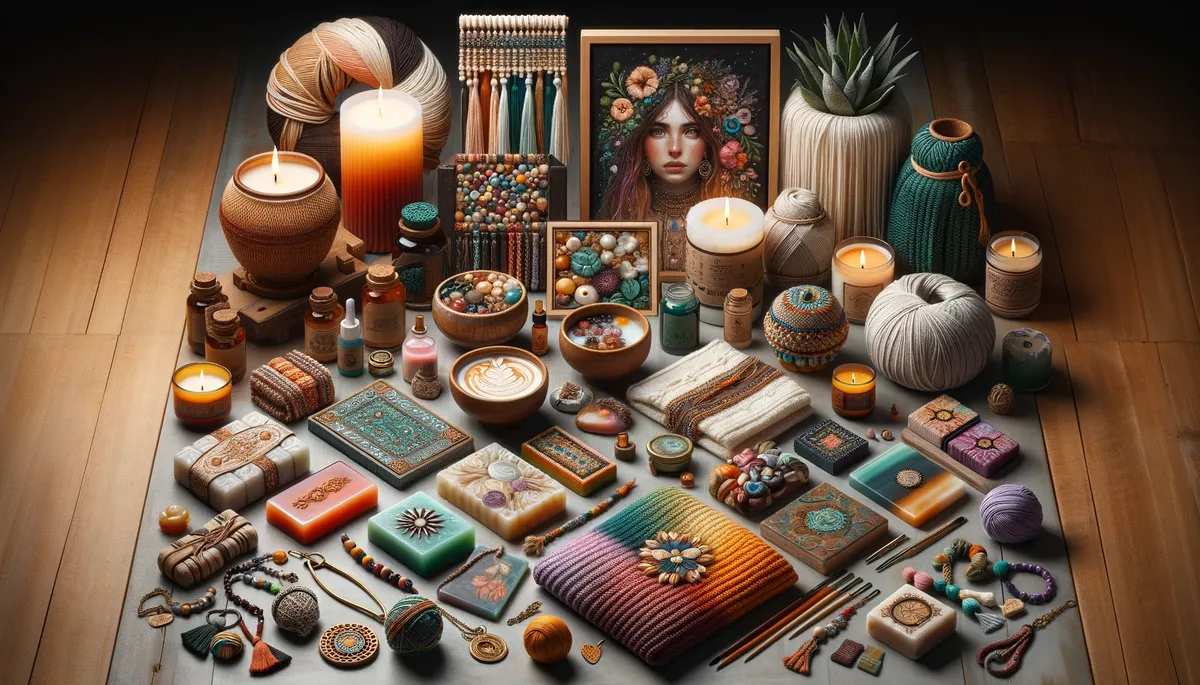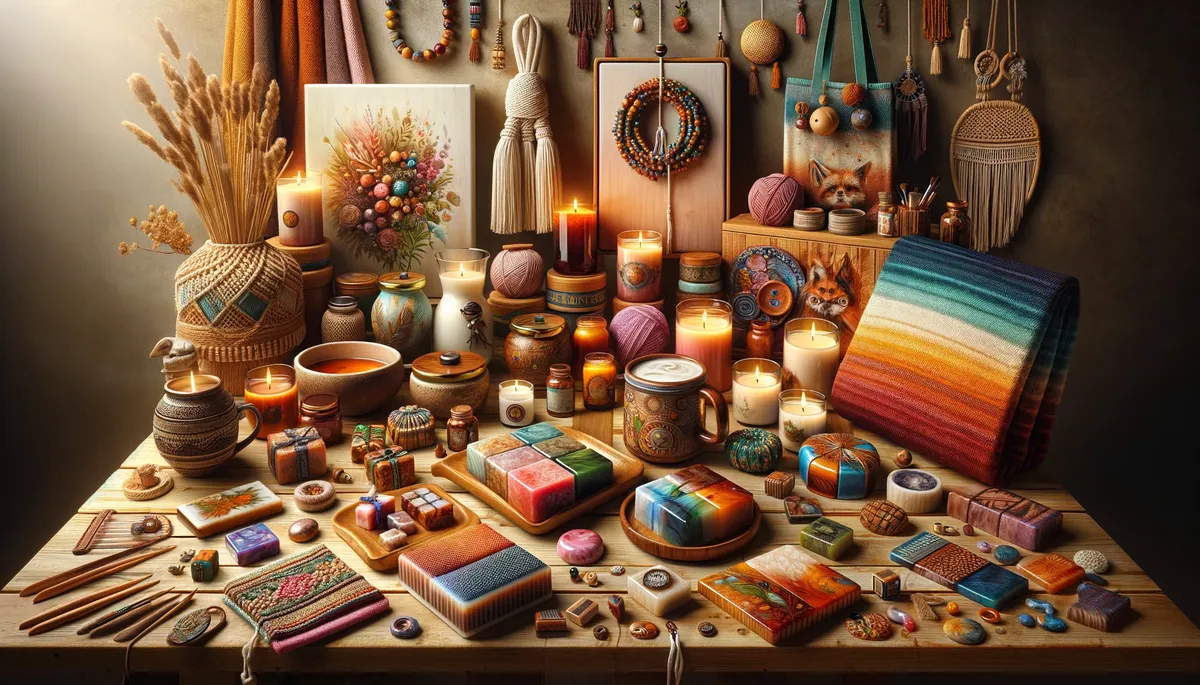Our handmade crafting guide targets creative entrepreneurs eager to tap escalating consumer demand for unconventional and ethical artisan wares reflecting personalized style statements through customization opportunities.
We analyze markets primed for small batch introductions spanning bath and body, jewelry, home decor and beyond – all selected for their ease of entry, growth trajectories and craft-selling profitability indexed against production input costs.
For example, the homemade candle niche lets creators effectively infuse purposeful scent profiles catered toward gifting occasions amplifying perceived value.
We also spotlight artful crafting displaying sophistication absent indulgent pricing like macramé wall tapestries and initial pendant necklaces made using widely available tools and materials.
Summary & Key Takeaways
Show- Handmade jewelry and customized tote bags are popular crafts for selling in 2024 due to the demand for sustainable and personalized products.
- Personalization techniques such as laser engraving, sublimation printing, and digital embroidery offer a unique selling proposition for both jewelry and tote bags.
- The choice of materials, such as recycled metals, ethically sourced gemstones, sustainable fabrics, and artisanal fabrics, influences the durability, aesthetic appeal, and perceived value of the crafts.
- Incorporating eco-friendly practices, such as using sustainable materials and offering eco-conscious soap making and candle crafting, can attract environmentally conscious consumers and contribute to profitability.
Each features characteristics allying with consumer sensibilities valuing originality and intentionality behind purchases rather than solely efficiency and scale.
By delicately balancing pragmatism, inventiveness and meaning our annual craft index aims at sustaining indie crafter livelihoods through unlocking niche prospects ripe for stability between passing trends.
12 Best Crafts to Make and Sell Online in 2024

For those backed by the conviction to thoughtfully brighten spaces and lives by converting raw inspiration skillfully into tangible beauty or function, traffic awaits at these unconventional crossroads.
Here are our top recommendations on the best handmade crafts to make and sell online:
1. Handmade Jewelry Trends
Consistently topping the list of profitable crafts, handmade jewelry trends in 2024 are reflecting a growing consumer preference for sustainable and personalized pieces.
The market is increasingly favoring artisans who demonstrate an innovative approach to design while maintaining an eco-conscious ethos. This surge in demand is not merely a fleeting inclination but rather a robust indicator of where consumer values are headed.
Notably, materials such as recycled metals, ethically sourced gemstones, and upcycled items are at the forefront of this trend.
The allure of these materials lies in their minimal environmental footprint and the unique story they impart to each piece.
In an age where mass production dominates, the distinctiveness of handcrafted jewelry resonates with consumers looking to express their individuality and ethical stance through their accessories.
Moreover, customization options are propelling sales, as buyers seek to infuse personal narratives into their adornments.
Jewelry makers are leveraging cutting-edge technologies like 3D printing to offer intricate and bespoke designs, further solidifying the appeal of handcrafted wares.
As we analyze the evolution of craft trends, it is apparent that the drive for personalization extends beyond jewelry.
This seamlessly transitions us to the burgeoning market for customized tote bags, another realm where individual expression and functionality converge.
2. Customized Tote Bags
Customized tote bags have emerged as a noteworthy trend, combining utility with personal expression in the consumer market.
The choice of material not only defines the durability and eco-friendliness of the product but also influences the perceived value by the eco-conscious customer base.
Meanwhile, the integration of trending designs with innovative personalization techniques can significantly elevate the uniqueness and market appeal of these crafted items.
Personalization Techniques
Personalization techniques offer a unique selling proposition for tote bags, tapping into the growing demand for bespoke accessories in 2024.
In a market inundated with mass-produced goods, the allure of customization distinguishes one’s product line.
Forward-thinking crafters are leveraging advanced methods such as laser engraving, high-definition sublimation printing, and digital embroidery to offer consumers a plethora of options for personal expression.
Incorporating consumer data analytics is pivotal in discerning popular personalization trends, enabling artisans to preemptively adjust their offerings.
The integration of interactive design software on e-commerce platforms also empowers customers to visualize their customizations in real-time, thereby enhancing user engagement and satisfaction.
This confluence of technology and artistry is not merely a trend but an evolution of consumerism in the craft sphere.
Material Selection
The choice of material is a critical factor in the creation of customized tote bags, as it directly influences durability, aesthetic appeal, and cost-effectiveness.
In the pursuit of innovation, creators must analyze emerging trends in consumer preferences and material technology.
Sustainable fabrics such as organic cotton, jute, and recycled polyesters are gaining traction, aligning with the eco-conscious zeitgeist of 2024.
These materials not only resonate with environmentally aware consumers but also offer long-term value through their resilience.
For the high-end market, artisanal fabrics with unique textures can set a brand apart. Cost analysis is imperative; while premium materials may command higher prices, they must also balance production expenses to ensure profitability.
An analytical approach to material selection can place a brand at the forefront of the customized tote bag market.
Trending Designs
While consumer demands continue to evolve, striking the perfect balance between functionality and style has become paramount in the design of customized tote bags for the 2024 marketplace.
Trending designs reflect a blend of aesthetic appeal and practicality, leveraging innovation to capture consumer interest. Insightful analysis of market trends has yielded several key elements that are shaping the future of tote bags:
- Minimalist patterns that convey sophistication
- Bold, personalized statements for individual expression
- Eco-conscious materials signaling a commitment to sustainability
- Tech-integrated features for enhanced usability
These design strategies not only cater to evolving preferences but also establish an emotional connection with the consumer, ensuring tote bags remain not just accessories, but extensions of personal ethos.
Transitioning to eco-consciousness, the next craft focus, eco-friendly soap making, aligns with the values of sustainability and personal well-being.
3. Eco-Friendly Soap Making
Eco-friendly soap making’s rise in popularity offers crafters a lucrative opportunity to tap into the growing demand for sustainable and homemade hygiene products.
As consumers become more environmentally conscious, they are increasingly seeking out products that are not only kind to their skin but also to the planet.
This shift in consumer behavior is a clear indicator of the market potential for soaps made with natural, organic ingredients, and eco-friendly packaging.
Analyzing the current trend, it’s evident that there is a burgeoning appreciation for artisanal soaps that boast transparency in ingredient sourcing and production methods.
Soap crafters who innovate with locally sourced ingredients, plastic-free packaging, and unique, natural scents can carve out a niche in this expanding market.
Moreover, the low overhead cost of small-batch production and the ability to sell directly to consumers online or at local markets adds to the appeal, making it an attractive business venture for eco-minded entrepreneurs.
Offering customization options can further enhance the product’s uniqueness, catering to individual preferences and sensitivities.
This personal touch not only fosters customer loyalty but also aligns with the increasing desire for bespoke, handcrafted goods.
Transitioning seamlessly from the realm of eco-conscious cleanliness, the next section will delve into the art of personalized candle crafting, another avenue where customization and sustainability are setting the sales alight.
4. Personalized Candle Crafting
Capitalizing on the desire for ambiance and individuality, personalized candle crafting emerges as a highly profitable craft for 2024, blending the allure of customization with the appeal of handcrafted goods.
The market’s pivot towards tailor-made products signals a clear opportunity for artisans.
By tapping into the burgeoning trend of personalization, candle makers can offer consumers an intimate connection to their purchases, elevating the standard candle to a bespoke piece of home decor.
In analyzing the upward trajectory of personalized candle crafting, several key factors play pivotal roles:
- Unique Aromas: Crafting signature scents that resonate with individual preferences.
- Custom Imagery: Incorporating personalized designs or messages that captivate the recipient’s personality.
- Eco-conscious Materials: Utilizing sustainable waxes and eco-friendly packaging, aligning with the ethical values of modern consumers.
- Interactive Experiences: Offering candle-making workshops or kits, fostering a deeper brand engagement.
As trend analysts predict, the future of personalized candle crafting lies in the art of experiential and emotional connection. This craft not only satisfies the longing for distinctive home accents but also caters to the growing DIY culture, where consumers take pride in contributing to the creation of their items.
Transitioning from the warmth of bespoke candles, we delve into the intricate world of trendy macramé creations, where craftsmanship meets bohemian chic.
5. Trendy Macramé Creations
Amidst a plethora of craft trends, macramé creations stand out as a highly profitable venture for artisans in 2024, offering a fusion of intricate knotting techniques with contemporary design.
This tactile art form has evolved beyond its bohemian roots to embrace minimalism and modern aesthetics, resonating with consumers seeking bespoke home décor and accessories.
The renaissance of macramé is underpinned by the versatility of its applications. From statement wall hangings that command attention in urban living spaces to delicate plant hangers that add a touch of greenery, these handcrafted pieces cater to an eco-conscious demographic that values sustainability and craftsmanship.
Analyzing market dynamics, macramé artisans who innovate within this medium find a significant competitive edge.
Incorporation of unconventional materials such as recycled textiles, metallic threads, and beads introduces a novel texture and visual interest that appeals to the avant-garde shopper.
Furthermore, the adaptability of macramé to various product sizes enables scalability, from intricate jewelry to expansive architectural installations, broadening the potential revenue streams.
In a marketplace that prizes originality, the bespoke nature of macramé artistry aligns with the consumer drive for personalization.
Crafters who adeptly tailor their offerings to align with individual customer preferences are likely to capture a loyal following and command premium prices, solidifying macramé’s position as a lucrative craft trend in 2024.
6. Decorative Resin Art Pieces
Branching out from the tactile world of macramé, decorative resin art pieces emerge as another profitable craft avenue, offering artists the chance to encapsulate beauty in durable, glossy finishes.
The interplay of translucency and color within resin art allows for a multitude of aesthetic expressions, from oceanic wave patterns to mesmerizing floral suspensions.
Innovative creators in 2024 are redefining the boundaries of this medium, making resin art pieces a sought-after commodity in the market of handmade crafts.
The allure of resin art lies in its versatility and the emotional resonance it can evoke. Consider the following elements that resin artists are infusing into their work to captivate and enchant potential buyers:
- Ephemeral Nature Scenes: Capturing the fleeting beauty of natural landscapes, preserved forever in crystal-clear resin.
- Vivid Color Schemes: Utilizing vibrant, eye-catching hues that add a pop of color to any living space.
- Personalized Encapsulations: Offering custom inclusion of items to create highly individualized and meaningful art pieces.
- Innovative Textures: Experimenting with additives to create tactile surfaces that invite touch and exploration.
These strategies not only underscore resin art’s profitability but also highlight a deep understanding of consumer desires for unique, emotionally engaging decor.
Artists are thus creating more than mere objects; they’re crafting visual experiences that resonate on a personal level with their clientele.
7. Upcycled Home Décor
In the realm of upcycled home décor, the selection of sustainable materials not only responds to growing eco-conscious consumer preferences but also offers cost efficiency for crafters.
The resurgence of vintage charm in home interiors has seen a heightened demand for crafts that embody a sense of history and uniqueness, presenting a lucrative niche for artisans.
Moreover, mastering DIY restoration techniques enables creators to transform discarded items into desirable, marketable products, capitalizing on the intersection of creativity and environmental responsibility.
Sustainable Materials Selection
Selecting sustainable materials, such as reclaimed wood or recycled glass, is crucial for creating eco-friendly upcycled home décor items that are both stylish and profitable in 2024.
In an era where consumers increasingly prioritize sustainability, the allure of upcycled items crafted from environmentally responsible materials can significantly enhance market appeal.
- Reclaimed Wood: Harness the rustic charm and storied past, resonating deeply with the nostalgia trend.
- Recycled Glass: Turn the clarity and uniqueness of glass into luminous art pieces that captivate eco-conscious buyers.
- Natural Fibers: Integrate organic textures from materials like jute or hemp to underscore authenticity and earthiness.
- Repurposed Metal: Transform industrial remnants into chic, metallic accents, embodying a fusion of innovation and heritage.
Vintage Charm Trends
The allure of vintage charm in upcycled home décor presents an opportunity for crafters to fuse timeless aesthetics with modern sustainability practices.
In 2024, the market’s appetite for such pieces is voracious, driven by a collective yearning for personalized spaces that tell a story.
Discerning creators are now innovating within this niche, transforming discarded materials into coveted treasures that resonate with the eco-conscious yet style-savvy consumer.
Analyzing the trend, it’s clear that upcycled home décor is not just a passing fancy but a substantial movement reflecting a deeper societal shift towards mindful consumption.
Savvy crafters are tapping into this zeitgeist, curating collections that blend patina with purpose, and in the process, carving out a lucrative segment in the crafts marketplace.
DIY Restoration Techniques
Capitalizing on the upcycled home décor trend, DIY restoration techniques empower crafters to transform everyday items into unique and marketable pieces.
These methods are not only cost-effective but also resonate with the growing consumer demand for sustainable and personalized home accents.
By analyzing the current market, one can identify a significant shift towards eco-consciousness and authenticity in home furnishings.
- Reclaimed Wood Accents: Stirring a sense of environmental stewardship and rustic allure
- Vintage Furniture Revival: Invoking nostalgia and timeless elegance
- Repurposed Glass Décor: Reflecting a commitment to zero waste with a hint of modern sophistication
- Customized Textile Art: Weaving together traditional craft and contemporary design
Crafters who master these restoration techniques position themselves at the forefront of a lucrative niche, blending innovation with cultural and environmental narratives.
8. Quirky Sticker Designs
Amid the bustling market for personalized items, quirky sticker designs stand out as both a creative and lucrative venture for entrepreneurs in 2024.
These small yet impactful pieces of art offer a canvas for expression, catering to diverse consumer interests from pop culture references to motivational quotes.
The low overhead costs and the potential for high margins make them an attractive product for craftpreneurs.
Analyzing the trends, stickers that resonate with current social movements or display a whimsical sense of humor are particularly marketable.
Additionally, sustainability has become a significant selling point, with eco-friendly materials being a priority for consumers.
| Trend | Description | Market Appeal |
|---|---|---|
| Nostalgia | Retro-themed designs | High among Millenials |
| Personalization | Customizable options | Strong in gift market |
| Eco-Friendly | Biodegradable materials | Growing environmental concern |
| Tech Integration | Augmented reality stickers | Emerging tech-savvy demographic |
| Collectibles | Series-based designs | High among niche collectors |
Entrepreneurs should consider these factors when developing their sticker lines to ensure not only the satisfaction of their buyers but also the scalability of their ventures.
As we delve further into the possibilities of craft commerce, the digital printables market emerges as another frontier ripe for exploration.
9. Digital Printables Market
As we pivot to the digital printables market, it is essential to recognize the evolving consumer preferences that drive current trends in printable products.
Effective pricing strategies are paramount in this market, with creators needing to balance consumer value perception and profitability.
Insight into the intersection of market demand and digital convenience will be critical for crafters seeking to capitalize on this segment in 2024.
Trends in Printables
While the crafts market continues to flourish, trends in digital printables are particularly noteworthy due to their low overhead and increasing consumer demand.
As we navigate the evolving landscape of e-commerce, it’s crucial to stay abreast of the current digital trends that shape consumer preferences and market dynamics.
Here are some of the emerging trends:
- Personalized planners and journals that cater to the burgeoning self-care movement
- Educational resources and worksheets reflecting the surge in homeschooling and remote learning
- Customizable home decor printables, offering a touch of personal flair for interior design enthusiasts
- Interactive printables that incorporate elements of gamification for both children and adults
These trends reflect a market that values personalization, education, and interactive experiences, setting the stage for innovative creators to capture the imagination and hearts of consumers worldwide.
Pricing Strategies
In the competitive landscape of the digital printables market, setting the right price point is crucial for maximizing profitability and ensuring market penetration. As creators navigate this arena, adopting a dynamic pricing strategy can be the key to staying relevant.
Analyzing market trends and consumer behavior offers insights into what buyers are willing to pay. Innovators in this space are increasingly leveraging data analytics to optimize prices in real-time, taking into account factors like seasonality, competition, and consumer engagement.
Additionally, offering tiered pricing structures for different levels of customization caters to a wider audience and can increase perceived value.
Ultimately, the goal is to find a balance between accessibility and exclusivity, thereby tapping into diverse customer segments while sustaining a profitable business model.
10. Hand-painted Glassware
Amid the resurgence of personalized home decor, hand-painted glassware emerges as a lucrative craft that blends artistic expression with practical functionality.
In the vibrant market of 2024, consumers crave unique items that tell a story and infuse their spaces with individuality.
Hand-painted glassware not only meets this demand but also offers a canvas for innovation and trendsetting design.
Analyzing the market, it becomes clear that hand-painted glassware is more than a mere trend; it is a reflection of the growing desire for handcrafted goods that elevate everyday experiences.
The following points capture the essence of this movement:
- Emotional resonance: Each brushstroke carries the artisan’s passion, creating a connection with the consumer.
- Exclusivity: No two pieces are identical, offering an exclusive allure to those seeking one-of-a-kind items.
- Sustainability: Hand-painting on reusable glassware appeals to eco-conscious buyers.
- Versatility: From wine glasses to decorative vases, the range of products is vast, catering to various preferences and occasions.
Incorporating advanced techniques such as temperature-resistant paints and exploring themes that resonate with contemporary cultural narratives, artisans can position their hand-painted glassware not merely as objects of use but as incarnations of art that enliven the quotidian.
11. Knitted Accessories for Comfort
The allure of coziness propels knitted accessories to the forefront of profitable crafting ventures in 2024. As consumers seek both warmth and style, the market for handcrafted knitted pieces shows a robust expansion.
These tactile creations resonate with the modern yearning for personalized, sustainable fashion, making them an optimal choice for artisans seeking to capitalize on the intersection of comfort and commerce.
In a milieu where innovation is paramount, knitters are reimagining traditional patterns and fibers to cater to a discerning clientele. Below is an analytical overview of knitted accessory trends that are currently shaping the market:
| Trend | Material Innovation | Market Appeal |
|---|---|---|
| Textured Scarves | Eco-friendly Alpaca Wool | High, due to sustainability concerns |
| Beanie Caps | Thermoregulating Yarns | Moderate, with an emphasis on tech-savvy consumers |
| Fingerless Gloves | Recycled Cashmere | Increasing, as eco-consciousness rises |
| Chunky Socks | Bamboo-Merino Blends | High, for their hypoallergenic properties |
| Infinity Cowls | Smart Textiles with Connectivity | Emerging, pushing the boundaries of traditional knitting |
These accessories not only furnish warmth but also serve as an emblem of the wearer’s commitment to ecologically conscious living and technological integration.
The savvy crafter will recognize this shift and innovate accordingly, ensuring their handiwork is not only comforting but also at the vanguard of the ever-evolving craft market.
12. Bespoke Pet Products
Capitalizing on the trend of personalized pet care, crafters are turning to bespoke pet products as a lucrative niche in the 2024 market.
As pet ownership continues to rise, so does the demand for unique, handcrafted items that cater to the individuality of each pet and its owner.
The market is ripe for innovators who can blend craftsmanship with personalization to create products that resonate on an emotional level with pet owners.
In this context, consider the emotional appeal of bespoke pet products:
- Custom-designed pet beds that match the owner’s home decor, reflecting the seamless integration of pet and personal lifestyle.
- Handcrafted toys using safe, non-toxic materials, showcasing concern for pet well-being and environmental responsibility.
- Personalized pet apparel, from sweaters to costumes, catering to the owner’s aesthetic preferences and the pet’s comfort.
- Tailor-made pet accessories like collars and leashes, with engraved names or messages, enhancing the special bond between pets and their owners.
Crafters who can tap into this emotion-driven demand with innovative and aesthetically appealing products are likely to establish a strong presence in the bespoke pet product market.
By offering custom solutions that address both functional needs and emotional desires, artisans can create a value proposition that is hard to resist for today’s discerning pet owners.
Final Thoughts: Which Profitable Crafts to Make and Sell You Choose?
In conclusion, the forecast for the 2024 craft market suggests a strong preference for personalized and eco-conscious items.
The outlined crafts, ranging from handmade jewelry to bespoke pet products, capitalize on growing consumer trends towards unique, sustainable, and custom-made goods.
Artisans who adapt to these trends and leverage digital platforms for the sale of digitally consumable goods are likely to find their offerings particularly profitable in the evolving marketplace.







